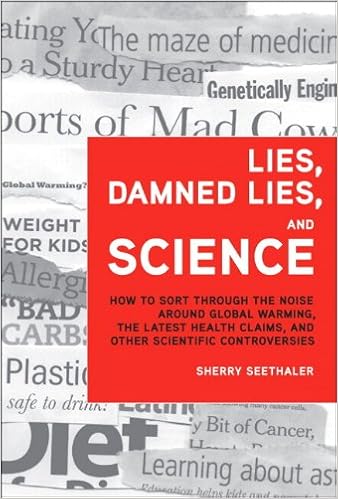
Free Downloads Lies, Damned Lies, And Science: How To Sort Through The Noise Around Global Warming, The Latest Health Claims, And Other Scientific Controversies (FT Press Science)

What's healthy? What's unhealthy? What's safe? What's dangerous? Watch the news, and it's easy to be overwhelmed by snippets of badly presented science: information that's incomplete, confusing, contradictory, out-of-context, wrong, or flat-out dishonest. In this book, Dr. Sherry Seethaler provides a "bag of tricks" for making sense of science in the news. You'll learn how to think more sensibly about everything from mad cow disease to global warming and make better science-related decisions in both your personal life and as a citizen. You'll begin by understanding how science really works and progresses, and why scientists sometimes disagree. Seethaler helps you assess the possible biases of those who make scientific claims in the media, and place scientific issues in appropriate context, so you can intelligently assess tradeoffs. You'll learn how to determine whether a new study is really meaningful; uncover the difference between cause and mere coincidence; figure out which statistics mean something, and which don't. Finally, drawing on her extensive experience as a science journalist, she reveals the tricks self-interested players use to mislead and confuse you, and points you to sources of information you can actually rely upon. Seethaler's many examples range from genetic engineering of crops to drug treatments for depression, but the techniques she teaches you will be invaluable in understanding any scientific controversy, in any area of science or health.

Series: FT Press Science
Paperback: 224 pages
Publisher: FT Press; 1 edition (January 23, 2009)
Language: English
ISBN-10: 0132849445
ISBN-13: 978-0132849449
Product Dimensions: 5.9 x 0.7 x 8.9 inches
Shipping Weight: 12 ounces (View shipping rates and policies)
Average Customer Review: 4.3 out of 5 stars See all reviews (43 customer reviews)
Best Sellers Rank: #137,915 in Books (See Top 100 in Books) #52 in Books > Science & Math > Essays & Commentary #180 in Books > Education & Teaching > Schools & Teaching > Instruction Methods > Science & Technology #4585 in Books > Textbooks > Science & Mathematics

A good way to read this book is to start with the conclusion where the author shares twenty thinking tools to evaluate findings. This is an abstract of the entire book including all the critical thinking processes the author covers.This is an excellent book that provides the qualitative critical thinking necessary for making better rational decisions regarding purchases, health care, and lifestyle. Many books impart the statistics to differentiate what is truly different from what is not. But, few books focus on framing the question correctly, understanding the biases of the stakeholders, and how to evaluate the findings. Ultimately, the qualitative thinking the author imparts is as important as the quantitative knowledge imparted by math books.The author does an excellent job explaining how science works. It is a constant feedback loop of battling hypothesis and rebuttals that confuse the public. But, if you make an effort to understand the issue, you will grasp the evolving nuances of the arguments. Through this process our knowledge invariably advances.Some highlights of the book include the matrix of stakeholders issues on page 34 regarding Global Warming, Drug approval, Genetically engineered food, and Mad cow disease. This matrix succinctly fleshes out all stakeholders positions on those four complex issues. The table of evidence being studied to understand climate change on page 83 is really thorough. Also, the concept of "pseudosymmetry of scientific authority" as explained on page 16 is interesting. It means the Media sometimes allocates as much print to both sides of an issue when the vast majority of the scientific community is on one side (that's why it is called pseudosymmetry).
Lies, Damned Lies, and Science: How to Sort Through the Noise Around Global Warming, the Latest Health Claims, and Other Scientific Controversies (FT Press Science) Current Controversies in Experimental Philosophy (Current Controversies in Philosophy) The Global Minotaur: America, Europe and the Future of the Global Economy (Economic Controversies) Air Pollution and Global Warming: History, Science, and Solutions Why Are the Ice Caps Melting?: The Dangers of Global Warming (Let's-Read-and-Find-Out Science 2) The Soil Will Save Us: How Scientists, Farmers, and Ranchers Are Tending the Soil to Reverse Global Warming Global Warming and the Dinosaurs: Fossil Discoveries at the Poles The Politically Incorrect Guide to Global Warming (and Environmentalism) Global Warming: Understanding the Forecast Global Warming: The Complete Briefing Sex, Lies and Insurance Claims Claims Made and Reported: A Journey Through D&O, E&O and Other Professional Lines of Insurance Giftology: The Art and Science of Using Gifts to Cut Through the Noise, Increase Referrals, and Strengthen Retention Global Health Care: Issues and Policies (Holtz, Global Health Care) Beautiful And Damned The Beautiful and Damned Just One Damned Thing After Another: The Chronicles of St Mary's, Book 1 We Are the Damned United: The Real Story of Brian Clough at Leeds United Robert B. Parker's Damned If You Do: A Jesse Stone Novel The Ultimate Panini Press Cookbook: More Than 200 Perfect-Every-Time Recipes for Making Panini - and Lots of Other Things - on Your Panini Press or Other Countertop Grill



